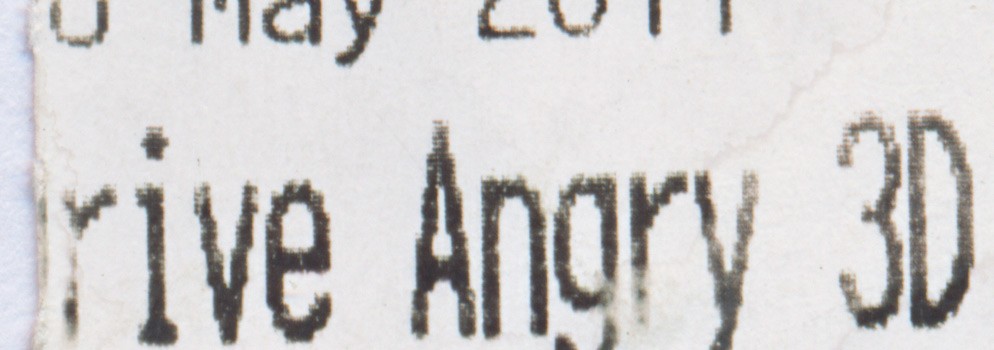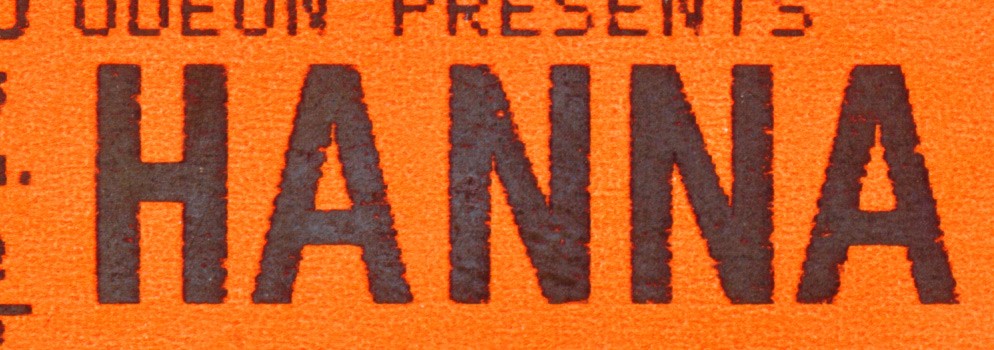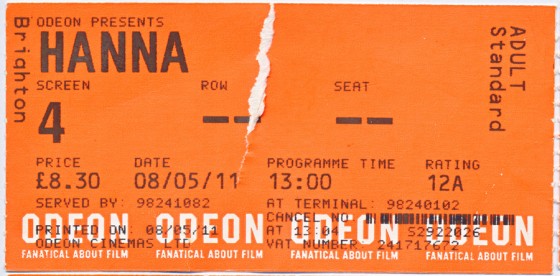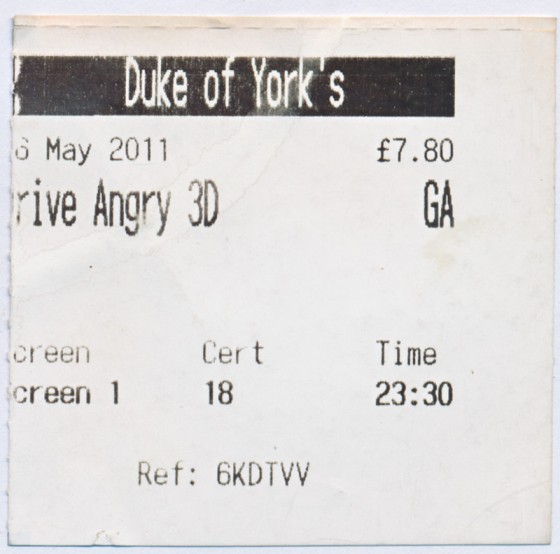Hanna & Drive Angry 3D

Leave out the plot parts.
Recently, I was baffled, as were you, by the transmission of Mr. Todd Haynes’ terrifyingly inert Mildred Pierce. I can understand wanting to remake it after reading the book and realizing ‘it’s different from the movie’, though, this shock reminds me, as pretty much everything does, of driving. How often have I screamed out, after having been narrowly missed by a driver/car that doesn’t understand that roads are social: ‘Other people on planet! Yes, it was shocking. When I was five!’
That Ida sleeps with Mildred’s paramour in the book and not in the movie was shocking. In the forties. And it is with great credit towards to the 1946 Michael Curtiz version that I actually remember the movie with this ending because it managed 1) to suggest it effectively, and 2) not bore and confuse me to death.
Hanna and Drive Angry are basically the same film: characters are going to a location and we don’t have any more information. Hanna fails because it depends on us finding out why. Drive Angry succeeds because we don’t care.
Halfway through, unable to stop watching because, well, of all the naked people (I have to give Mr. Haynes his due for that), and with the hope that, you know, something would happen, I looked up ‘Mildred Pie…’, and was quickly pleased to find Google filling in ‘rce hbo review’. If that’s not democracy…ah, right, that’s not actually democracy. Never mind.
In any case, I no longer felt alone: others were reaching out as I was, yearning to know: Was this being tolerated? Why was this being tolerated? Who was tolerating it? How can they be stopped short of violence? How can they be stopped inclusive of violence?
One of the top hits was Mr. Stephen King’s feh review, which talked about ‘performance’ (bleech) as if it can be surgically removed from story, character, tone, and, most importantly, tedium. It can’t, by the way. But Mr. King’s toleration of this ennui-fest, possibly through his (admittedly justified) love of Ms. Winslet, betrayed his own ethos when he quoted Mr. Elmore Leonard (and I’m embarrassed to say that this was the first time I had come across this dictum. Elmore Leonard should teach writing to everybody. We need someone to ignore when we’re making terrible movies). Mr. Leonard said, and Mr. King chose to ignore him when speaking of Mildred Pierce: ‘leave out the boring parts.’
Mr. Haynes, if you want to see how this is done, see Drive Angry. And see it in 3D.


Disorientation in films is tricky. You do have to withhold things, since if you showed everything in the first ten seconds, you would have to have one of those annoying ‘contains flashing images’ warnings. Also what if you knew the ending of a film and were forced to watch it anyway? That would be boring, right…George Lucas? Sorry, right…all the people who paid money to see episodes one through three only to discover…Darth Vader is Luke Skywalker’s father?
Right…me?
As someone obsessed with the writing aspect of films, I often think that tension has a lot to due with plot, the tension between what we think is going to happen and what happens. I am wrong, but only temporarily, since I am right in seeing that I am wrong. Though having said that, please allow me to contradict myself: Drive Angry, begins with various close-ups of a 1966 Buick Riviera driving through a science-fiction fantasy suspension bridge that for some reason has a lot of leaves on it, I imagine to give the Buick Riviera something to drive through. You really have no idea where you are, what’s going on, or even if you’re watching a movie. Where are we going? Who’s driving? Why didn’t they use a 1973 Riviera with the wraparound rear window? What’s that? Where am I?
You’re in a theater, watching the greatest movie ever made.
It took me a while to figure out why, and I’m not too proud to say that it was Hanna that showed me the way. Not too proud, because I’ve been caught seeing a film directed by Mr. Joe Wright. Hanna and Drive Angry are basically the same film: characters are going to a location and we don’t have any more information. Hanna fails because it depends on us finding out why. Drive Angry succeeds because we don’t care.
The theory goes like this: there are two tensions when you’re watching a film. One is within the film, between the characters and their situation. B wants extract revenge from X who wants money from Y who wants to sleep with Z. It’s totally understandable: I mean, look at the size of Z’s serif!
The other, and much more important tension is between the film and the real world. You must, for example, relate to wanting sex, money or revenge. I think we can agree that this is a subset of the population big enough to explain the popularity of Hollywood. But the third tension (how many are there again?) is the way in which the film relates to real world, a world that includes every film you have ever seen, and to the way in which those films refers to what could or couldn’t happen in the real world. That’s four tensions now, plus all the extra ones between the film world, the real world, and the real world within the film. Plus…
Start again. Let’s say you make a real cool movie where the main character turns out to be ghooooossssssttttt himself. This works 1) because there’s a tension in the real world over what happens when you die, and the world that the film creates where ghosts exist. But there’s also a tension over whether or not this is a familiar bit (sorry, should have said: ‘2)’). If you made this film in 1990, you’d be a genius. And you would have also prevented The Happening from ever being made. Thank you, time traveller, thank you. If you made a movie with this story in 2011, you’d bore the audience to death.


Hanna, thus, has two strikes against it, aside from the general air of wankiness. The first is the fact that it’s living in a post Kick-Ass world, where extremely violent pre-pubescent girls are no longer surprising or erotic. The second is that we learn, very, very, very slowly, that she was…part of supersoldier experiment! Yes, it is surprising that they couldn’t be bothered to to think of better surprise. Without the normal intra-film tension between the characters and situation (we can’t get tense if we don’t know what’s happening), or the tension between what we know about the real world and the one that the film inhabits, you get a lack of tension. And there’s a word for that. Tensionositylessness.
This seems like we’re talking about originality and boredom, as in doing something we’ve never seen before in a way we’ve seen before, but not exactly: it is possible to be derivative as long as you’re doing something impossible. Telling the truth to someone’s face, a common trope in comedy, virtually never happens, and when it does, it’s only funny to the audience that doesn’t exist. If you turn around right now, you’ll see that you are not, in fact, trapped behind a movie screen, and you have just made the actual person in front of you hate you forever. Tell him his haircut makes him look nice.
To best illustrate what the hell I’m talking about, let us consider our two case studies. The first (Hanna) presents us with the death of St. Sebastian. In what may be the most pretentious move of the year, Mr. Wright stages the death of one of the characters with lots of arrows, in reference – that no doubt all the critics ‘got’ – to the Guido Reni paintings. He does this so that our erstwhile heroine can conveniently use one of the arrows to kill the last baddie and say the same line that she did at the beginning of the film. It’s symmetry! That’s the same as competent filmmaking, right?
Hanna

$0.50
In Drive Angry, Mr. Nicolas Cage drinks beer out of the skull of the bad guy. This is in reference to Cezanne’s famous: Our Savior Gets Drunk With Nazis On The Raft Of The Medusa. No, it isn’t. It doesn’t refer to anything (except for skulls and beer, of course). It doesn’t further the plot. It doesn’t expand the character. It’s just great. When you’re watching Drive Angry, what with all its retro explotationosity, it deceives you into thinking: ‘They don’t make them like this anymore’. But they never did. And they never will again.
Drive Angry lives to create an impossible universe. And yes, there’s minimal plot, character, or even structure. But it survives on the principle that you haven’t seen this before in a film, and that you want to. After – in what may have been the strangest alliances history – the born-again Christians and radical 1980s feminists got together and explained that we should be ashamed of nudity in films, we existed in the (real) world where the (film) world was no longer representative of the (real film) world (with boobies). Scratch that; the (film real) world (also with boobies). Don’t give me that look. You know exactly what I’m talking about.
The introduction of the heroine, for example, is a crucial scene. She will say something like, ‘I’m indecisive, and whiny about it. No wonder everybody loves me! ‘Sorry, that’s Twilight. We’ll be saving that for later. No, she’ll say something like, ‘It sure is hard work taking care of my orphaned nephew,’ and we, as audience members will breath a collective sigh of relief: ‘Aww, she’s motherly and potentially a virgin, satisfying the 1980s radical feminist and born-again Christian in all of us.’ When we meet our heroine in Drive Angry, she says, and I quote: ‘And I told him if I see that big ol’ dick of his anywhere near my face I’m gonna bite it in half’, and I, as an audience member, breathed a sigh of relief and said, out loud (I have witnesses): ‘I like her! ‘And this is even before we see her singing along to ‘Fuck the pain away’. And just so you don’t thing I’m being genderist about who I want to be slutty, it’s also a universe where a bar can be inexplicably named ‘Bull by the Balls’, and where Nicolas Cage can be involved in a elaborate shootout while having sex.
Read that again; I didn’t say after having been interrupted having sex. I said while having sex.
But so as not to leave out the 1980s radical feminist or born-again Christians, Drive Angry also includes 3D superimpositions of blood over flashbacks, which unlike normal flashbacks, don’t actually tell you anything (see above). There’s a giant billboard of a snake that says: ‘Here it is!’, which is never explained or referred to again. There’s Mr. William Fichnter having a grand time playing The Accountant, who may be a demon. Or a ghost. Or someone who does a good Nicolas Cage impression at one point. It’s a little hazy. There are some devil worshippers who may been bringing back a new dominion of Satan. But maybe not. Also, a little hazy.
Am I reading too much into what is essentially an exploitation picture? No, you are reading too much into what is simply mediocre filmmaking, and too forgiving of ‘acting’ or ‘character’ or ‘mood’, which is usually, in fact, nothing happening. This may be an extreme version of Mr. Elmore Leonard’s dictum, but plot, character and even sense can, and should be jettisoned in the service of keeping us entertained. After the heavy reliance of close-ups on The Buick Riveira in the film’s opening, the car unceremoniously crashes, and Mr. Cage simply gets another one. The Buick is never seen or referred to again. This car (which will soon crash as well) has a license plate that reads ‘DRV ANGY’, as if the film doesn’t even have time for vowels.
NTHR SHLD U.
The Take – Drive Angry 3D

$35.00
The Lonely Comments Section

 [logo]
[logo]

